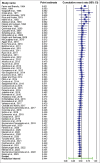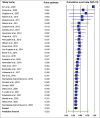Herd-level seroprevalence, molecular prevalence, and trends of Coxiella burnetii (Q fever) in cattle worldwide: A systematic review and meta-analysis
- PMID: 39897364
- PMCID: PMC11784057
- DOI: 10.14202/vetworld.2024.2811-2828
Herd-level seroprevalence, molecular prevalence, and trends of Coxiella burnetii (Q fever) in cattle worldwide: A systematic review and meta-analysis
Abstract
Background and aim: Cattle are the reservoir host of Coxiella burnetii, a causative agent of Q fever. Pooling herd-level prevalence data from individual studies would help determine the global prevalence of C. burnetii in cattle herds. This study aimed to estimate the global herd-level seroprevalence and molecular prevalence of C. burnetii in cattle, explore sources of heterogeneity, and determine trends and cumulative evidence of the pooled prevalence over time.
Materials and methods: Relevant studies were retrieved from PubMed, Scopus, and Web of Science and then screened for possible inclusion. A random-effects model was used for all meta-analyses. Subgroup meta-analysis and meta-regression were used to explore some sources of heterogeneity associated with the pooled prevalence and to determine the trends of C. burnetii in cattle herds over the study years (1961-2020). A cumulative meta-analysis was used to determine the cumulative evidence of the pooled prevalence over the publication years.
Results: Of the 1541 citations, 86 studies with 38,057 cattle herds from 42 countries on six continents were included in the meta-analysis. The global herd-level seroprevalence of C. burnetii in cattle was estimated to be 44.4% (95% confidence interval [CI], 37.9%-51.1%), with high heterogeneity among the included studies. The herd-level seroprevalence was significantly higher in dairy than in beef cattle herds (49.0% [95% CI: 41.9%-56.2%] vs. 14.5% [95% CI: 5.8%-32.1%], respectively). The global herd-level molecular prevalence of C. burnetii in cattle was estimated to be 32.3% (95% CI: 25.3%-40.01%), with high heterogeneity among the included studies. Herd-level molecular prevalence was significantly different among continents. The herd-level molecular prevalence ranged from 12.8% (95% CI: 7.1%-21.9%) in Asia to 70.0% (95% CI: 36.3%-90.5%) in North America. Regarding trends, the herd-level seroprevalence of C. burnetii in cattle did not change significantlyover the study years.
Conclusion: The global herd-level seroprevalence and herd-level molecular prevalence of C. burnetii in cattle were high, estimated at 44% and 32%, respectively. The herd-level seroprevalence trend did not significantly change over time. This result indicates that cattle remain a major reservoir host for C. burnetii and pose a potential risk to human health.
Keywords: Coxiella burnetii; Q fever; cattle; herd; prevalence.
Copyright: © Konputtar, et al.
Conflict of interest statement
The authors declare that they have no competing interests.
Figures





Similar articles
-
Molecular prevalence of Coxiella burnetii in bulk-tank milk from bovine dairy herds: Systematic review and meta-analysis.One Health. 2020 Dec 24;12:100208. doi: 10.1016/j.onehlt.2020.100208. eCollection 2021 Jun. One Health. 2020. PMID: 33553561 Free PMC article. Review.
-
Prevalence and risk factors of Coxiella burnetii seropositivity in Danish beef and dairy cattle at slaughter adjusted for test uncertainty.Prev Vet Med. 2014 Mar 1;113(4):504-11. doi: 10.1016/j.prevetmed.2014.01.018. Epub 2014 Jan 21. Prev Vet Med. 2014. PMID: 24485706
-
Q Fever Dairy Herd Status Determination Based on Serological and Molecular Analysis of Bulk Tank Milk.Transbound Emerg Dis. 2016 Apr;63(2):e293-300. doi: 10.1111/tbed.12275. Epub 2014 Sep 11. Transbound Emerg Dis. 2016. PMID: 25208655
-
Seroprevalence of Q fever in naturally infected dairy cattle herds.Prev Vet Med. 2011 Aug 1;101(1-2):51-7. doi: 10.1016/j.prevetmed.2011.05.005. Epub 2011 Jun 8. Prev Vet Med. 2011. PMID: 21645936
-
Molecular prevalence of Coxiella burnetii in cheese samples: Systematic review and meta-analysis.Vet Med Sci. 2024 Jan;10(1):e1335. doi: 10.1002/vms3.1335. Epub 2023 Dec 15. Vet Med Sci. 2024. PMID: 38100127 Free PMC article.
References
-
- Rathish B, Pillay R, Wilson A, Pillay V.V. Comprehensive Review of Bioterrorism. Treasure Island, FL: StatPearls Publishing; 2024. - PubMed
-
- Bwatota S.F, Cook E.A.J, Bronsvoort B.M. de C, Wheelhouse N, Hernandez-Castor L.E, Shirima G.M. Epidemiology of Q-fever in domestic ruminants and humans in Africa. A systematic review. CABI One Health. 2022:1–17.
-
- Angelakis E, Raoult D. Q fever. Vet. Microbiol. 2010;140(3–4):297–309. - PubMed
-
- Tagoe J.N.A, Yeboah C, Behene E, Kumordjie S, Nimo-Paintsil S, Attram N, Nyarko E.O, Carroll J.A, Fox A.T, Watters C, Koram K, Anang A.K, Sanders T, Letizia A.G. Coinfection of malaria and bacterial pathogens among acute febrile patients in selected clinics in Ghana. Am. J. Trop. Med. Hyg. 2023;109(5):1036–1046. - PMC - PubMed
LinkOut - more resources
Full Text Sources
